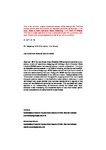On Mapping EEG Information into Music
| dc.contributor.author | Eaton, J | |
| dc.contributor.author | Miranda, Eduardo | |
| dc.contributor.editor | Miranda E | |
| dc.contributor.editor | Castet J | |
| dc.date.accessioned | 2018-03-06T11:50:56Z | |
| dc.date.available | 2018-03-06T11:50:56Z | |
| dc.date.issued | 2018-01-01 | |
| dc.identifier.isbn | 978-1-4471-6583-5 | |
| dc.identifier.other | 10 | |
| dc.identifier.uri | http://hdl.handle.net/10026.1/10981 | |
| dc.description.abstract |
With the rise of ever-more affordable EEG equipment available to musicians, artists and researchers, designing and building a Brain-Computer Music Interface (BCMI) system has recently become a realistic achievement. This chapter discusses previous research in the fields of mapping, sonification and musification in the context of designing a BCMI system and will be of particular interest to those who seek to develop their own. Design of a BCMI requires unique consider-ations due to the characteristics of the EEG as a human interface device (HID). This chapter analyses traditional strategies for mapping control from brain waves alongside previous research in bio-feedback musical systems. Advances in music technology have helped provide more complex approaches with regards to how music can be affected and controlled by brainwaves. This, paralleled with devel-opments in our understanding of brainwave activity has helped push brain-computer music interfacing into innovative realms of real-time musical perfor-mance, composition and applications for music therapy. | |
| dc.format.extent | 221-254 | |
| dc.language.iso | en | |
| dc.publisher | Springer-Verlag London | |
| dc.relation.ispartof | Guide to Brain-Computer Music Interfacing | |
| dc.subject | Brain-Computer Interface | |
| dc.subject | Brain-Computer Music Interface | |
| dc.subject | Computer Music | |
| dc.title | On Mapping EEG Information into Music | |
| dc.type | chapter | |
| plymouth.publisher-url | http://www.springer.com/gb/book/9781447165835#aboutBook | |
| plymouth.publication-status | Published | |
| dc.identifier.doi | 10.1007/978-1-4471-6584-2_10 | |
| plymouth.organisational-group | /Plymouth | |
| plymouth.organisational-group | /Plymouth/Faculty of Arts, Humanities and Business | |
| plymouth.organisational-group | /Plymouth/Faculty of Arts, Humanities and Business/School of Society and Culture | |
| plymouth.organisational-group | /Plymouth/REF 2021 Researchers by UoA | |
| plymouth.organisational-group | /Plymouth/REF 2021 Researchers by UoA/UoA33 Music, Drama, Dance, Performing Arts, Film and Screen Studies | |
| plymouth.organisational-group | /Plymouth/Users by role | |
| plymouth.organisational-group | /Plymouth/Users by role/Academics | |
| dc.publisher.place | London | |
| dc.rights.embargoperiod | Not known | |
| rioxxterms.funder | Engineering and Physical Sciences Research Council | |
| rioxxterms.identifier.project | Brain-Computer Interface for Monitoring and Inducing Affective States | |
| rioxxterms.versionofrecord | 10.1007/978-1-4471-6584-2_10 | |
| rioxxterms.licenseref.uri | http://www.rioxx.net/licenses/all-rights-reserved | |
| rioxxterms.type | Book chapter | |
| plymouth.funder | Brain-Computer Interface for Monitoring and Inducing Affective States::Engineering and Physical Sciences Research Council |


